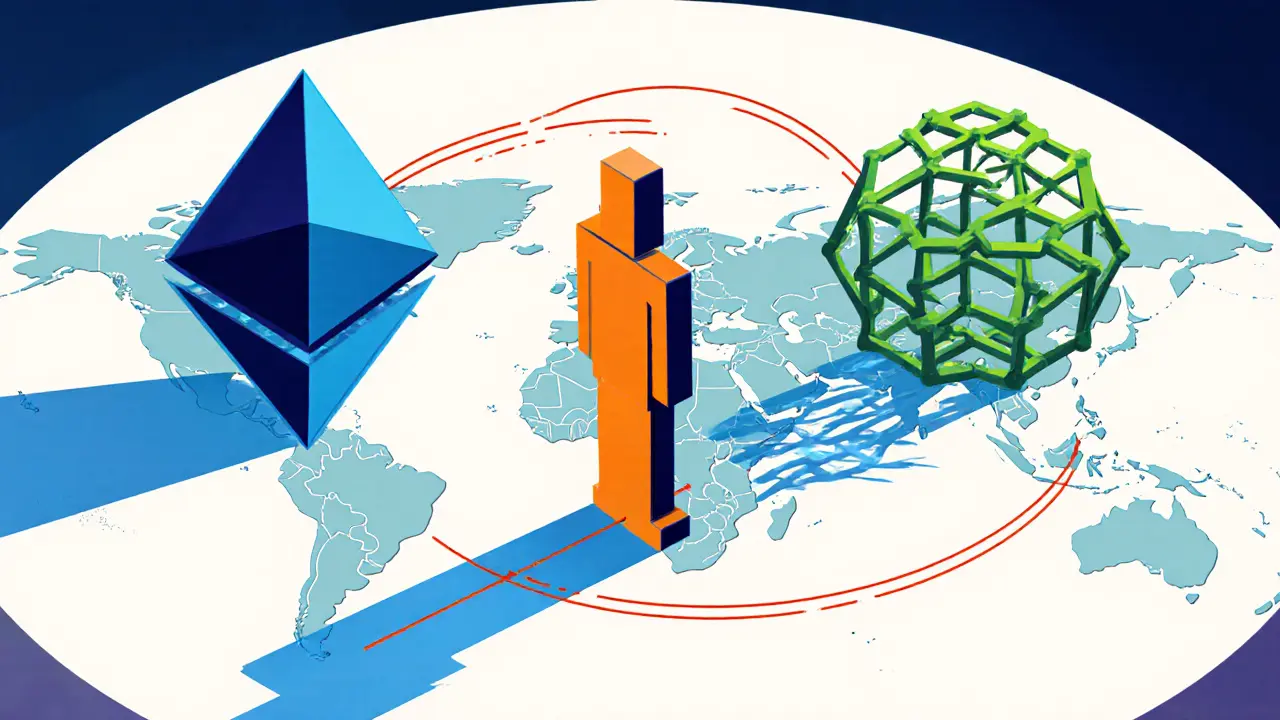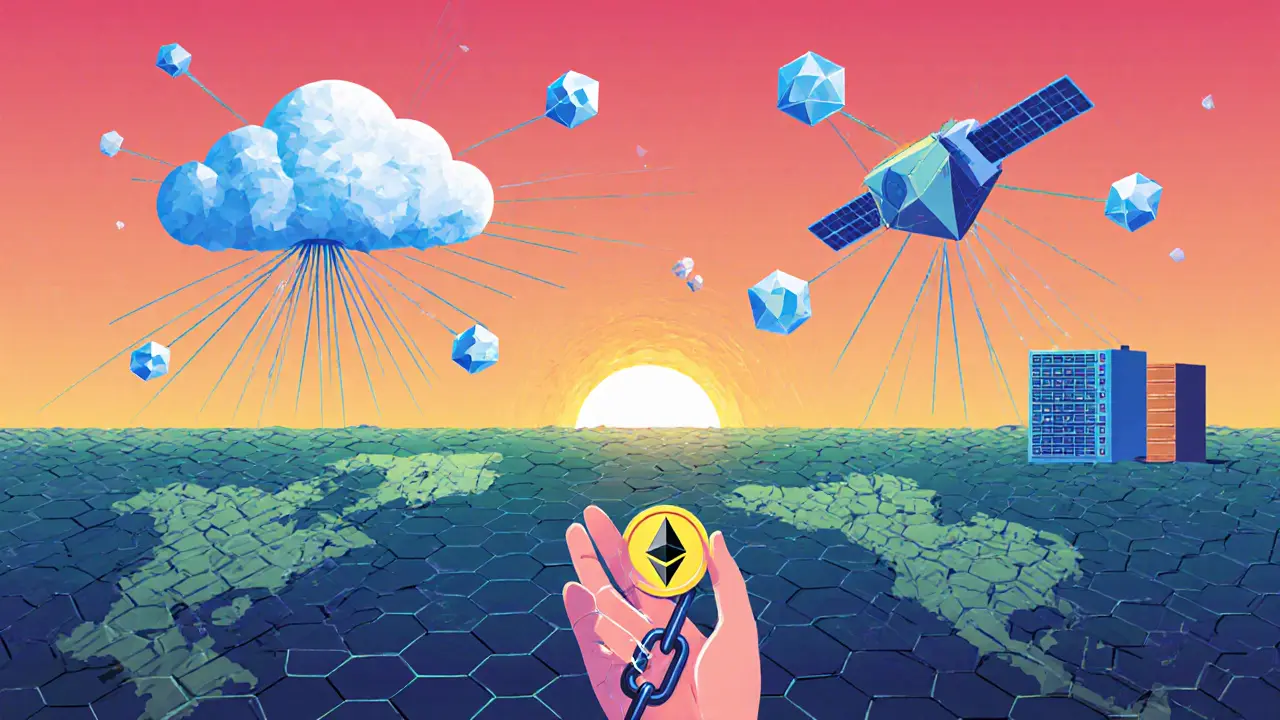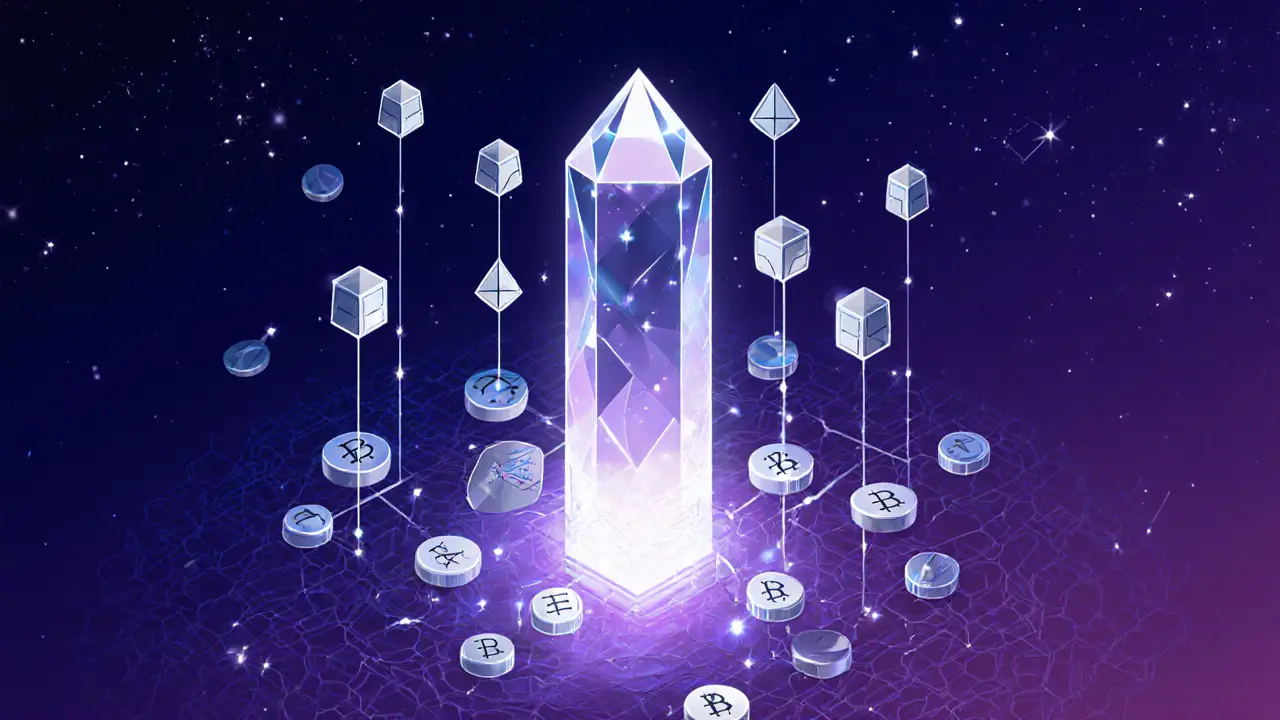Validator networks aren’t just technical details buried in blockchain whitepapers-they’re the silent guardians keeping every transaction honest. Without them, blockchains would collapse into chaos. Imagine a ledger where anyone could rewrite history. That’s what happens without validators. Today, over 500,000 validators secure Ethereum alone. And that number is only growing. The future of validator networks isn’t about bigger hardware or faster chips-it’s about making security accessible, fair, and resilient.
What Validators Actually Do
Validators aren’t miners. They don’t burn electricity solving math puzzles. Instead, they lock up their own cryptocurrency-called staking-to earn the right to verify transactions. Think of it like putting down a deposit to prove you’re trustworthy. If you behave honestly, you get paid. If you cheat, you lose part of your deposit. This is called slashing.
Every time a new block is created, validators vote on it. They don’t just check if the transactions are valid-they also confirm the entire chain’s history hasn’t been tampered with. Ethereum calls these votes attestations. Each one is a digital signature that says, “This block is correct.” When enough validators agree, the block becomes final. No more reversals. No more doubts.
This system replaced Bitcoin-style mining because it’s 99.95% more energy efficient. Ethereum’s switch in 2022 cut its electricity use from the level of a small country to that of a single data center. That’s not just good for the planet-it’s good for adoption.
How Validator Networks Are Structured Today
Not all validator networks work the same way. Ethereum uses a pure Proof-of-Stake model. To become a validator, you need 32 ETH. That’s about $100,000 right now. It’s expensive, but it ensures only serious participants join. Each validator runs software on a dedicated machine, 24/7. Miss a vote? Get slashed. Go offline too long? Lose rewards.
Solana takes a different approach. Its validators need top-tier hardware: high-end CPUs, fast SSDs, and gigabit internet. It’s less about how much you stake and more about how well you can handle speed. This makes Solana fast-but also harder for regular people to join.
Cosmos is built for interchain communication. Its validators secure not just one chain, but dozens. Through the Inter-Blockchain Communication (IBC) protocol, validators help move assets between chains like Cosmos Hub, Osmosis, and others. This creates a web of interconnected networks, all relying on shared validator trust.
Then there’s Delegated Proof-of-Stake (DPoS), used by networks like Polygon and Cardano. Here, token holders vote for a small group of validators. The top 100 or so get to produce blocks. It’s faster, but it’s also more centralized. You’re trusting a few people with the whole system.
The Rise of Staking-as-a-Service
Most people don’t have $100,000 or the technical skills to run a validator node. That’s where staking-as-a-service providers come in. Companies like Lido, Rocket Pool, and Kraken let you stake as little as 0.01 ETH. They run the nodes for you. In return, you get a share of the rewards.
But there’s a catch. When you stake through Lido, you don’t get ETH back-you get stETH, a token that represents your stake. This is called liquid staking. It lets you use your staked assets in DeFi-lend them, trade them, earn yield elsewhere. That’s powerful. But it also creates new risks. If stETH loses its peg to ETH, you could lose money even if the network is fine.
Professional validators now operate like small businesses. They manage hundreds of nodes across multiple cloud providers. They have redundancy, automated monitoring, and emergency response teams. The days of hobbyist validators running rigs in their basements are fading. The bar for entry is rising.

Why Centralization Is the Biggest Threat
Validator networks were built to be decentralized. But reality is creeping in. The top 10 staking providers control over 40% of Ethereum’s total stake. That’s a problem. If one of them goes down-or gets hacked-thousands of validators could fail at once. The network could stall.
Even worse, some validators are hosted on the same cloud provider. Amazon Web Services, Google Cloud, and Microsoft Azure host a large chunk of Ethereum’s validators. If AWS has an outage, it doesn’t just affect one company-it could knock out entire sections of the blockchain.
Some argue this isn’t centralization-it’s efficiency. But efficiency without resilience is dangerous. The future of validator networks depends on breaking this pattern. Solutions like validator clustering, geographic diversification, and incentive-based decentralization are being tested. Ethereum’s upcoming upgrades aim to reduce the impact of any single validator’s failure.
What’s Next for Validator Networks
The next wave of innovation isn’t about more validators-it’s about smarter ones. Upgrades like Danksharding (Ethereum’s 2025 roadmap) will let validators process data in parallel instead of in sequence. This means higher throughput without needing more nodes. Validators will still vote on blocks, but they’ll only need to verify small pieces of data, not the whole chain.
Slashing protection is also evolving. Right now, if your node crashes because of a power outage or a software bug, you get punished-even if you did nothing wrong. New tools like MEV-Boost and proposer-builder separation are reducing accidental penalties. Some networks are even experimenting with insurance pools that cover slashing losses for honest validators.
There’s also a push for cross-chain validator sharing. Imagine one validator securing both Ethereum and a new Layer 2 chain without running two separate nodes. That’s already being tested in projects like EigenLayer. It lets validators “re-stake” their ETH to protect other protocols, earning extra rewards while strengthening the whole ecosystem.

What This Means for You
If you’re holding ETH, SOL, or any Proof-of-Stake token, you’re already part of a validator network-even if you don’t run a node. Your stake contributes to network security. And that’s valuable. The more people stake, the harder it is to attack the chain.
But don’t just stake blindly. Check who’s running the validator you’re trusting. Are they spread across regions? Do they use multiple cloud providers? Do they have a public track record? Avoid services that don’t disclose their infrastructure. You’re not just earning rewards-you’re helping protect the blockchain.
For developers and operators, the future is about tooling. Better monitoring dashboards, automated recovery scripts, and open-source validator clients are making it easier to stay online. The goal isn’t to make everyone a validator. It’s to make sure the ones who are, are reliable.
The Bigger Picture
Validator networks are the backbone of Web3. They’re what make decentralized finance, NFTs, and smart contracts possible. As more industries-from banking to logistics-start using blockchains, the demand for secure, scalable validators will only grow.
By 2027, it’s likely we’ll see validator networks running on satellites, in edge data centers, and even on low-power devices in remote areas. The technology is becoming more inclusive, not less. The real winners won’t be the biggest stakers-they’ll be the networks that make participation fair, safe, and simple.
The future of validator networks isn’t about more power. It’s about more trust. And that’s something no amount of computing can buy.
What is a blockchain validator?
A blockchain validator is a participant who locks up cryptocurrency (stakes it) to help verify and record transactions on a blockchain. They propose new blocks, vote on their validity, and earn rewards in return. If they act dishonestly or go offline too often, they lose part of their stake-a penalty called slashing.
How do validators make money?
Validators earn rewards in the network’s native token, like ETH or SOL, for correctly validating blocks and making attestations. They also collect transaction fees from users. On Ethereum, annual returns typically range from 4% to 7%, depending on how many people are staking and how well the validator performs.
Can anyone become a validator?
Technically yes, but it’s not easy. On Ethereum, you need 32 ETH (about $100,000) and reliable hardware with 24/7 uptime. Most people use staking-as-a-service providers like Lido or Kraken, which let them stake smaller amounts and get rewards without running their own node.
What’s the difference between a validator and a miner?
Miners use powerful computers to solve complex math problems to validate blocks (Proof-of-Work). Validators lock up cryptocurrency to earn the right to validate (Proof-of-Stake). Miners spend electricity; validators spend capital. Validators are far more energy-efficient and are replacing miners in most modern blockchains.
Are validator networks secure?
Yes, but only if they’re well-distributed. Validator networks use economic incentives to discourage bad behavior-slashing penalties make attacks expensive. However, if too many validators are controlled by one company or hosted on the same cloud provider, the network becomes vulnerable to outages or coordinated attacks.
What is liquid staking?
Liquid staking lets you stake your crypto while still using it elsewhere. For example, when you stake ETH with Lido, you receive stETH, a token that represents your staked ETH. You can trade, lend, or use stETH in DeFi apps while still earning staking rewards. But if stETH loses its peg to ETH, you could lose value even if the blockchain is fine.

DeeDee Kallam
November 1, 2025 AT 11:36ok so like validators are just crypto babysitters?? lol i staked 0.5 eth on lido and got steth and now i’m basically a blockchain guardian?? my cat slept through the whole thing and i still got rewards 😅
Helen Hardman
November 3, 2025 AT 05:35Y’ALL. I just wanna say how amazing it is that we’re moving from energy-guzzling miners to people just locking up their crypto like a trust fund for the future. I mean, imagine if we applied this same logic to climate change-like, ‘Hey, if you pollute, you lose your deposit.’ Validators aren’t just tech-they’re a moral upgrade. I’ve been running a node for 18 months now, and honestly, the peace of mind? Worth every second. Even when my pi-hole broke and my node went offline for 4 hours and I got slashed 0.003 ETH (RIP my coffee fund), I still felt proud. We’re building something that doesn’t just work-it works *for everyone*.
Josh Serum
November 5, 2025 AT 03:11Actually, you’re all missing the point. Validators aren’t even the real story. The real innovation is how staking-as-a-service has created a new class of financial intermediaries that are *more* centralized than banks. Lido controls 32% of Ethereum’s stake. That’s not decentralization-that’s oligarchy with a blockchain veneer. And don’t even get me started on how stETH is being used as collateral in DeFi. That’s a time bomb waiting for a 10% de-peg. You’re not securing the network-you’re gambling on a Ponzi of tokenized IOUs.
Genevieve Rachal
November 6, 2025 AT 05:41Wow. So we’re now romanticizing people who run servers for crypto rewards like they’re monks in a digital monastery. Meanwhile, 80% of validators are on AWS. The whole thing’s a facade. You think you’re decentralizing? You’re just outsourcing control to Silicon Valley. And you call this progress? Pathetic.
Phil Higgins
November 8, 2025 AT 04:43There’s a deeper truth here: trust isn’t built by code. It’s built by distribution. If every validator is in the same cloud region, running the same software, under the same corporate umbrella-we haven’t solved centralization. We’ve just moved it from Wall Street to AWS. The real question isn’t ‘how many validators?’ but ‘how many independent actors?’ We need geographic, hardware, and ownership diversity. Not just more nodes. More *kinds* of nodes.
Elizabeth Melendez
November 9, 2025 AT 04:40Okay but have y’all heard about EigenLayer? Like, imagine your ETH validator doesn’t just secure Ethereum but ALSO helps secure a bunch of new Layer 2s and rollups-like a superhero with multiple capes. You get extra rewards just for being a good citizen of the whole ecosystem. And the slashing protection pools? Genius. People are finally building safety nets so honest nodes don’t get punished for dumb internet outages. I’ve been using a home server with a UPS and a 4G backup-no cloud, no drama-and I’ve never been slashed. It’s doable. You just gotta care a little.
Malinda Black
November 9, 2025 AT 16:39It’s funny how we praise decentralization but still treat staking like a passive investment. You wouldn’t just throw money into a mutual fund and call it ‘owning the system.’ Why do we do it with crypto? If you’re going to be part of the security layer, at least learn what ‘attestation’ means. Or at least ask your staking provider if they use multi-cloud. If they don’t, you’re not helping the network-you’re just renting a yield.
Mehak Sharma
November 11, 2025 AT 08:06Validation is the quiet heartbeat of Web3 not the flashy NFT or the meme coin hype. In India we have farmers using blockchain for crop supply chains and they don’t need to run nodes-they trust the validators behind the scenes. That’s the magic. Not the 32 ETH. Not the stETH. But the invisible architecture that lets a village in Rajasthan verify a transaction without a bank. That’s real inclusion. And yes the cloud centralization is scary but the solution isn’t fear-it’s open source tools, community-run relays, and education. We can build this. Together.
bob marley
November 12, 2025 AT 20:59Wow. So the guy who wrote this thinks validators are noble. Meanwhile, the top 3 staking pools control half the chain and they all use AWS. Congrats. You built a religion around a cloud outage waiting to happen. And you call this innovation? Pathetic. Just buy Bitcoin and shut up.
Chris Strife
November 13, 2025 AT 16:17Validator networks are the future. End of story. America leads. China tries to copy. Europe complains. The rest follow. If you don’t stake you’re not part of the movement. Period.